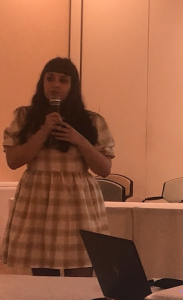In this month’s blog I am grateful to introduce you to one of the University College Dublin, Contextual Behavioural Science Lab’s (UCD CBS lab) rising stars, Alison Stapleton. In her blog Alison talks about the fascinating topic of rule governed behavior (RGB). RGB has been of interest to behavior analysts for decades and is the topic of Alison’s doctoral research. Thank you Alison for joining the ABAI Symbolic Language and Thought Blog series. -Dr. Louise McHugh, University College Dublin, ABAI Symbolic Language and Thought Blog series host 2020.
Alison Stapleton: I am a part-time procrastinator and full-time PhD student in the School of Psychology, University College Dublin. My PhD research focuses on rule-following across cultures and periods of lifespan development. I am a member of the Association for Contextual Behavioral Science who is passionate about knowledge transfer, collaboration, and Netflix.

Rule-governed behavior is a useful verbal repertoire that allows us to respond to the world around us. For example, Lizzo’s rule “if he don’t love you anymore, then walk your fine ass out the door” allows her to avoid contacting the aversive consequence of heartbreak. Similarly, Shrek’s rule “you’ll never know if you don’t go” allows him to pursue meaningful values despite any self-doubt that shows up.
However, while rules can be adaptive in some contexts, they can also undermine guidance by direct experience, overwhelming other sources of learning. In this way, rule-following can be a double-edged sword, allowing us to bypass trial and error but simultaneously precipitating insensitivity to environmental changes not specified in the rule.
Within Relational Frame Theory, there are different functional classes of rule-following. The first type we typically learn is pliance. Pliance is rule-following under the control of socially mediated consequences (i.e., social approval/disapproval) [1]. For example, if my supervisor tells me that I should “write a blog post for ABAI” and I only write the blog post to receive her praise, then I am adhering to a ply.

Me trying to squeeze as many pop culture references as possible into this blog.
Pliance in and of itself is not bad [2], however, once pliance becomes generalized and social approval becomes our main source of reinforcement, problems arise. For example, generalized pliance complicates valued living and often blinds us to the actual consequences of our actions [3]. Furthermore, because social contexts often encourage us to avoid aversive private events, individuals with generalized pliance will likely develop greater psychological inflexibility [1].
Given the problems associated with generalized pliance, it is vital we recognize when it is occurring. Some linguistic cues which suggest pliance is occurring are detailed in a book by Matthieu Villatte and colleagues [4]. For example, pliance is likely involved if an individual states a rule without specifying a consequence (e.g., “When things go wrong I should just keep swimming”). While it is possible the individual is just not explicitly stating the consequence, if they struggle to state a consequence when prompted (e.g., “For what purpose?” … “I don’t know”) or state a cause rather than consequence (e.g., “because that’s what I should do”), then pliance is likely occurring. For individuals with generalized pliance, rule-following for arbitrary/unspecified consequences dominates and so we would expect most of their rules to follow this pattern.
However, it is important to emphasize that just because individuals are not explicitly stating consequences within their rules, this does not mean they are unequivocally engaged in pliance. It may be the case that the individuals are unable to articulate the consequences because they are responding habitually (e.g., “I’ve always followed this rule”) or with low complexity (e.g., “I just do”). Moreover, even if an individual states a rule with a specified consequence that appears arbitrary, for that individual, the consequence may actually be non-arbitrary based on their learning history.
You cannot determine whether a consequence is arbitrary or non-arbitrary for an individual without having a complete understanding of their learning history and knowledge of whether the relationship between the rule and consequence has been reinforced/ derived. When it comes to identifying generalized pliance, there are no fixed and definitive guidelines that will apply across all individuals and contexts.
So, when trying to use linguistic cues to identify pliant rule-following, remember rule one: there are no rules.
References
1. Ruiz, F., Suárez-Falcón, J., Barbero-Rubio, A., & Flórez, C. (2019). Development and initial validation of the generalized pliance questionnaire. Journal of Contextual Behavioral Science, 12, 189-198. https://doi.org/10.1016/j.jcbs. 2018.03.003
2. Stapleton, A., & McHugh, L. (2020). Adolescent correlates of the Generalized Pliance Questionnaire–Children. Journal of Contextual Behavioral Science, 15, 131-134. https://doi.org/10.1016/j.jcbs.2019.12.006
3. Törneke, N., Luciano, C., & Valdivia-Salas, S. (2008). Rule-governed behavior and psychological problems. International Journal of Psychology and Psychological Therapy, 8(2), 141– 156.
4. Villatte, M., Villatte, J. L., & Hayes, S. C. (2015). Mastering the clinical conversation: Language as intervention. New York, NY: Guilford Publications.
